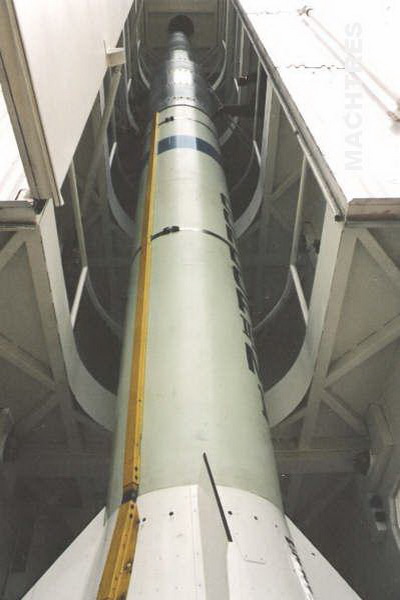Condor Missile
The General Direction of Space Development, which is independent from the Argentine Air force, was in charge of the development of the Condor Rocket.
Technical Details of the Condor I: 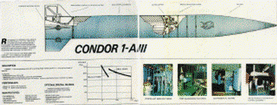 Approximate Length: 8 meters.
Approximate Length: 8 meters.
Maximum fuselage: 0.80 metros
Stages: One.
Fuel: solid fuel, made up of HTPB (Hydroxyl Terminated Poly Butadiene, the same that is used in the Thiokol boosters of the Space Shuttle). - This fuel is made in the Falda del Carmen plant.
The Fixed Nozzle is made from the following materials (probably epoxy resin-trioxide from molybdenum).
The Head is made of an epoxy resin.
Direction System: it uses inertial-aerodynamics, using spoolers; this means that the rocket was only stable during flight when it was launched vertically or depending on the angle of the takeoff. - The rocket didn't possess any guiding system. The Condor I was destined to be a motor rocket, and it eventually was used in atmospheric investigations, with a peak of 300 km and a payload of 400-500 kg. The first static motor test was supposedly done in mid-1983. The first Condor I was going to be launched at the end of 1985, something that never happened.
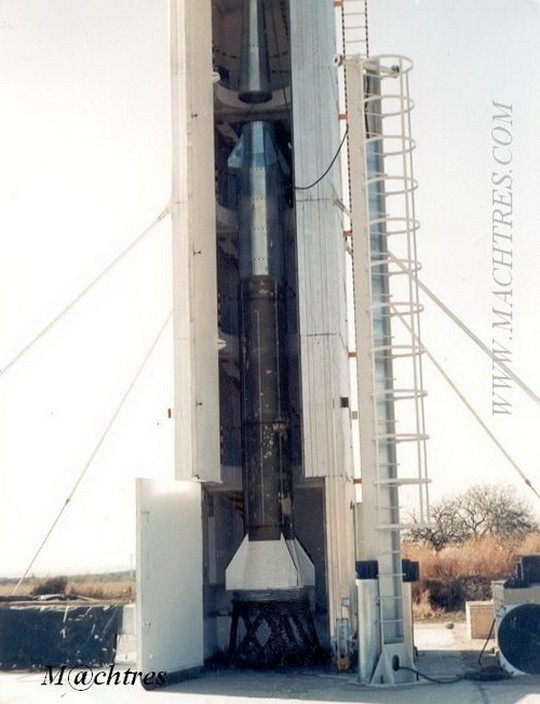 The second stage of the project was the development of the Condor II, but before they were ever able to test the technology in flight, they believe that they developed the Alacran (code named Condor I-A III) that was 6.5 meters long and 0.56 meters wide. It could carry 250 kg of cargo and could reach distances of 115 km. - the head of the missile is made from materials used with the Alacran or Scorpion rocket and it has the capacity to carry a warhead with a cluster bomb, which contains 1000 grenades CAM-1, with a 2-block blast radius. This missile would have the same type of combustion and construction characteristics as the Condor I, but, in all reality, it is a tactical artillery missile, similar to the Chilean "Rayo", but with a longer range and more powerful. The Alacran Missile was fired a few times since 1988 (see note 2 at the bottom), including one time during the presidency of C. Menem, which was fired from the Chamical in the Rioja Province. It was even tested while carrying a warhead. In an article from the 1990 Jan-Feb edition of the Airspace magazine about the Air Force and the weapons systems that they were investigating in that era, they talk about the head of the missile being made from materials used with the Alacran or Scorpion missile and that it had the capacity to carry a warhead with a cluster bomb, which contains 1000 grenades CAM-1, with a 2-block blast radius. In the article, they explain that they were going to present the land-to-land missile VT-561 (the ex-Alacran), under the project named FAS-320. They said that the total weight of the missile was 1532 kg with a payload of 400kg and whose fuel weighed 788kg. They also explained that it had a range of 120km and a peak of 40 km high.
The second stage of the project was the development of the Condor II, but before they were ever able to test the technology in flight, they believe that they developed the Alacran (code named Condor I-A III) that was 6.5 meters long and 0.56 meters wide. It could carry 250 kg of cargo and could reach distances of 115 km. - the head of the missile is made from materials used with the Alacran or Scorpion rocket and it has the capacity to carry a warhead with a cluster bomb, which contains 1000 grenades CAM-1, with a 2-block blast radius. This missile would have the same type of combustion and construction characteristics as the Condor I, but, in all reality, it is a tactical artillery missile, similar to the Chilean "Rayo", but with a longer range and more powerful. The Alacran Missile was fired a few times since 1988 (see note 2 at the bottom), including one time during the presidency of C. Menem, which was fired from the Chamical in the Rioja Province. It was even tested while carrying a warhead. In an article from the 1990 Jan-Feb edition of the Airspace magazine about the Air Force and the weapons systems that they were investigating in that era, they talk about the head of the missile being made from materials used with the Alacran or Scorpion missile and that it had the capacity to carry a warhead with a cluster bomb, which contains 1000 grenades CAM-1, with a 2-block blast radius. In the article, they explain that they were going to present the land-to-land missile VT-561 (the ex-Alacran), under the project named FAS-320. They said that the total weight of the missile was 1532 kg with a payload of 400kg and whose fuel weighed 788kg. They also explained that it had a range of 120km and a peak of 40 km high.
In an article from the 1990 Jan-Feb edition of the Airspace magazine about the Air Force and the weapons systems that they were investigating in that era, they talk about the head of the missile being made from materials used with the Alacran or Scorpion missile and that it had the capacity to carry to carry a warhead with a cluster bomb, which contains 1000 grenades CAM-1, with a 2 block blast radius. In the article, they explain that they were going to present the land-to-land missile VT-561 (the ex-Alacran), under the project named FAS-320.
They said that the total weight of the missile was 1532 kg with a payload of 400kg and whose fuel weighed 788kg. They also explained that it had a range of 120km and a peak of 40 km high.
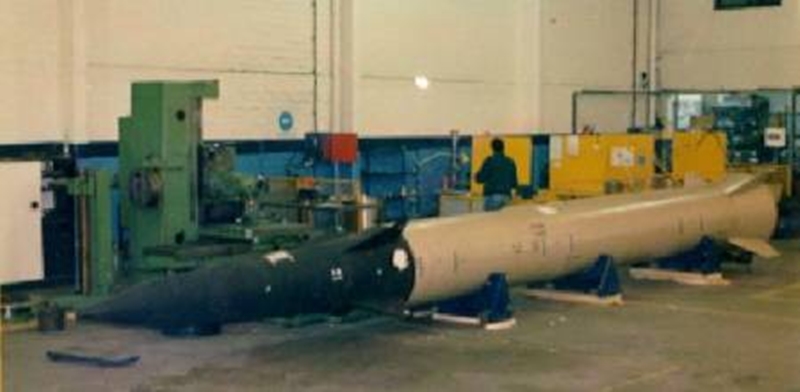
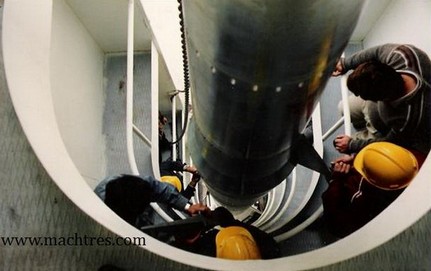
Technical details of the Condor II
THE CONDOR II, was a two-staged rocket, that had a system of thrust vector control through a moveable nozzle in each one of the stages, aerodynamic surfaces to control the roll of the rocket in both stages, a package sensor for altitude control with cold gas, and a velocity control system. Three integrated and intercommunicated computers controlled all of this. The rocket was 16 meters tall with a diameter of 0.8 meters. It had a pay load of 500kg and was supposed to be able to reach targets up to 1000km. Although this was obviously a military version of the Condor II, they believed that they could use a modified version of the same thing, adding a third stage, to send small satellites into orbit. It is very possible that they completed some of these Condor II rockets, but we are not sure if they were ever tested in flight. A part of the cancellation of the project came from a lack of funding, but at the end, it was really determined by international pressure. The greater part of the equipment used in the development of the rocket was dismantled and sent to the USA to be destroyed in 1993, according to the agreement signed between the two governments. From that moment, there haven't officially been any other projects, with peaceful purposes, for the development of rockets in Argentina, because they didn't know how to take advantage of the technology acquired.
